必修五unit-5 first aid 集体备课
- 格式:doc
- 大小:162.47 KB
- 文档页数:23
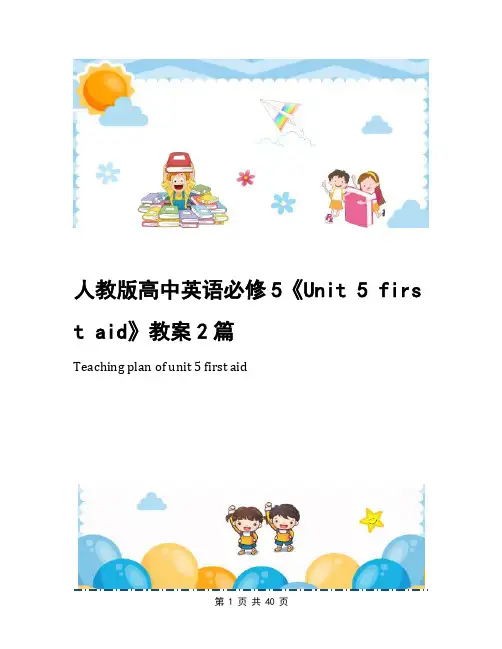
人教版高中英语必修5《Unit 5 firs t aid》教案2篇Teaching plan of unit 5 first aid人教版高中英语必修5《Unit 5 first aid》教案2篇前言:英语作为在许多国际组织或者会议上都是必需语言,几乎所有学校选择英语作为其主要或唯一的外语必修课。
英语教学涉及多种专业理论知识,包括语言学、第二语言习得、词汇学、句法学、文体学、语料库理论、认知心理学等内容。
本教案根据英语课程标准的要求和教学对象的特点,将教学诸要素有序安排,确定合适的教学方案的设想和计划、并以启迪发展学生智力为根本目的。
便于学习和使用,本文档下载后内容可按需编辑修改及打印。
本文简要目录如下:【下载该文档后使用Word打开,按住键盘Ctrl键且鼠标单击目录内容即可跳转到对应篇章】1、篇章1:人教版高中英语必修5《Unit 5 first aid》教案2、篇章2:人教版高中英语必修5《Unit 5 first aid》教案篇章1:人教版高中英语必修5《Unit 5 first aid》教案一、教学内容分析本单元以“急救”为中心话题。
本案例把教材的Warming up 和Reading部分结合起来,旨在通过教学,使学生了解相关的急救知识,并能用所学的有关first aid的知识,根据不同情况提出急救措施。
同时通过教学激发学生进一步学习急救知识的兴趣和树立安全意识,意义重大。
二、教学目标1、语言目标:学习掌握教学内容中的重点字、词、句;2、能力目标:阅读速度和技巧的训练;3、情感目标:教育学生帮助他人于危急时的良好情操;通过讨论等小组活动培养协作精神;通过课堂教学活动激发学生英语学习兴趣。
三、学习者特征分析所执教的班级学生是我从高一开始教的,到了高二已经有了一定的英语基础。
该班学生的主要特点是能讲敢讲(我在这方面一直鼓励学生),课堂气氛活跃。
本单元的教学内容与生活实际相结合,学生比较熟悉这个主题内容,也能引起他们的表达欲望和学习兴趣。
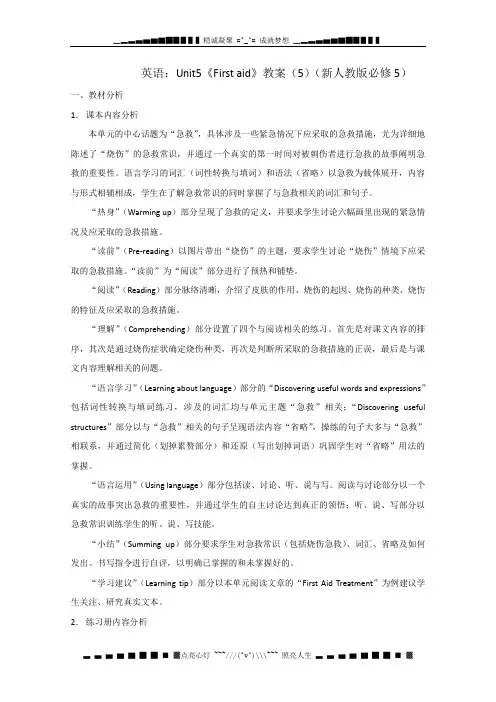
英语:Unit5《First aid》教案(5)(新人教版必修5)一、教材分析1.课本内容分析本单元的中心话题为“急救”,具体涉及一些紧急情况下应采取的急救措施,尤为详细地陈述了“烧伤”的急救常识,并通过一个真实的第一时间对被刺伤者进行急救的故事阐明急救的重要性。
语言学习的词汇(词性转换与填词)和语法(省略)以急救为载体展开,内容与形式相辅相成,学生在了解急救常识的同时掌握了与急救相关的词汇和句子。
“热身”(Warming up)部分呈现了急救的定义,并要求学生讨论六幅画里出现的紧急情况及应采取的急救措施。
“读前”(Pre-reading)以图片带出“烧伤”的主题,要求学生讨论“烧伤”情境下应采取的急救措施。
“读前”为“阅读”部分进行了预热和铺垫。
“阅读”(Reading)部分脉络清晰,介绍了皮肤的作用、烧伤的起因、烧伤的种类、烧伤的特征及应采取的急救措施。
“理解”(Comprehending)部分设置了四个与阅读相关的练习。
首先是对课文内容的排序,其次是通过烧伤症状确定烧伤种类,再次是判断所采取的急救措施的正误,最后是与课文内容理解相关的问题。
“语言学习”(Learning about language)部分的“Discovering useful words and expressions”包括词性转换与填词练习,涉及的词汇均与单元主题“急救”相关;“Discovering useful structures”部分以与“急救”相关的句子呈现语法内容“省略”,操练的句子大多与“急救”相联系,并通过简化(划掉累赘部分)和还原(写出划掉词语)巩固学生对“省略”用法的掌握。
“语言运用”(Using language)部分包括读、讨论、听、说与写。
阅读与讨论部分以一个真实的故事突出急救的重要性,并通过学生的自主讨论达到真正的领悟;听、说、写部分以急救常识训练学生的听、说、写技能。
“小结”(Summing up)部分要求学生对急救常识(包括烧伤急救)、词汇、省略及如何发出、书写指令进行自评,以明确已掌握的和未掌握好的。
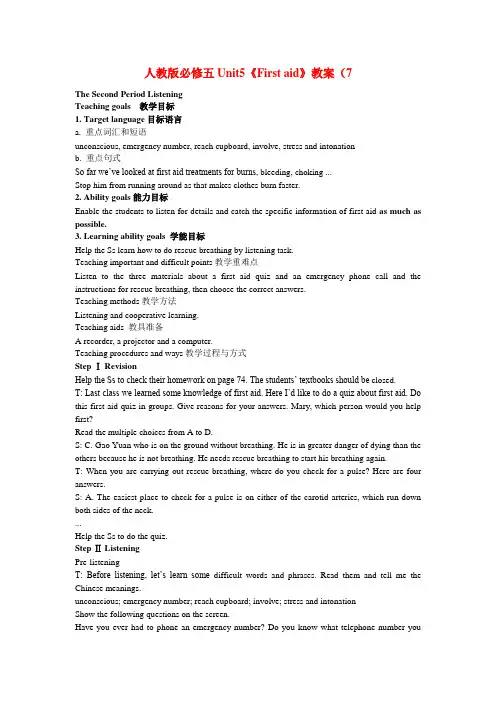
人教版必修五Unit5《First aid》教案(7The Second Period ListeningTeaching goals 教学目标1. Target language目标语言a. 重点词汇和短语unconscious, emergency number, reach cupboard, involve, stress and intonationb. 重点句式So far we’ve looked at first aid treatments for burns, bleeding, choking ...Stop him from running around as that makes clothes burn faster.2. Ability goals能力目标Enable the students to listen for details and catch the specific information of first aid as much as possible.3. Learning ability goals 学能目标Help the Ss learn how to do rescue breathing by listening task.Teaching important and difficult points教学重难点Listen to the three materials about a first aid quiz and an emergency phone call and the instructions for rescue breathing, then choose the correct answers.Teaching methods教学方法Listening and cooperative learning.Teaching aids 教具准备A recorder, a projector and a computer.Teaching procedures and ways教学过程与方式Step Ⅰ RevisionHelp the Ss to check their homework on page 74. The students’ textbooks should be closed.T: Last class we learned some knowledge of first aid. Here I’d like to do a quiz about first aid. Do this first aid quiz in groups. Give reasons for your answers. Mary, which person would you help first?Read the multiple choices from A to D.S: C. Gao Yuan who is on the ground without breathing. He is in greater danger of dying than the others because he is not breathing. He needs rescue breathing to start his breathing again.T: When you are carrying out rescue breathing, where do you check for a pulse? Here are four answers.S: A. The easiest place to check for a pulse is on either of the carotid arteries, which run down both sides of the neck....Help the Ss to do the quiz.Step Ⅱ ListeningPre-listeningT: Before listening, let’s learn some difficult words and phrases. Read them and tell me the Chinese meanings.unconscious; emergency number; reach cupboard; involve; stress and intonationShow the following questions on the screen.Have you ever had to phone an emergency number? Do you know what telephone number youwould call in a medical emergency?What telephone number you would call in a fire emergency?And what telephone number you would call in a police emergency?Let the Ss discuss these questions. Give some necessary help.Ss: 120 is the emergency phone number for the ambulance;110 for police station;119 for fire station.T: OK. When we make an emergency call, what should we pay attention to? Yes, we should re-member to tell where we are, what happened, the telephone number etc. Now, we are going to listen to an emergency phone call. Listen attentively and get the general idea.ListeningPlay the tape twice. And then ask the Ss some questions.T: What can you hear in the listening?S: The listening presents an emergency phone call in which a woman is asking for an ambulance for her daughter who has had an accident.T: I play it the second time; you need to fill in the blanks. While you are listening, you’d better make notes of the listening points. Listen to the conversation and complete the table on page 69, pay attention to the key words.Check the answers.Make the Ss understand all the four questions. Play the tape and ask them to answer the questions in pairs. And then check the answers with the whole class.T: Can you remember the phrases the operator used to try and make Mrs Grant feel more relaxed? S: Now calm down; Now take a deep breath.T: Are there any other phrases you didn’t understand?...Play the tape again and help the Ss to deal with the difficulties.Step Ⅲ Listening ( P73)Pre- listeningT: Now let’s go on to do another listening practice. Please turn to page 73. Here are some pictures of how to do rescue breathing. We call the way CPR. What do you think rescue breathing is?S: Rescue breathing is when you help someone who has stopped breathing to start breathing again. While listeningT: Listen to the instructions for rescue breathing, number the boxes for the correct order. Write an instruction under each picture. Now discuss the order in groups. Number the boxes to show the correct order of the pictures. Write an instruction under each picture.Ss: 7-5-2-4-8-6-1-31 check if conscious2 put into recovery position3 clear airway4 check if breathing5 blow into mouth and watch for breathing6 check pulse7 continue rescue breathing8 put into recovery positionPost-listeningT: Now let’s look at the pictures, can you use them as guide to tell each other how to do rescue breathing.Ss: 1. We should call for help, then check whether unconscious.2. We should put the person into the recovery position.3. We may clear anything in the airway.4. Then we should check for breathing.5. Blow into mouth using the mouth- to- mouth method.6. Check pulse.7. We should continue breathing at 15 breath a minute.8. At last when the person breaths again, put him/her in the recovery position.T: Yes, you are right. Rescue breathing is very important in our daily life. I hope one day when you need it, you can use it well.Step Ⅳ Listening (P39)T: Besides the rescue breathing, there are other ways to do first aids. Now, let’s learn more about first aid. Turn to page 39. Here is a quiz. While you listen to it, you don’t need to catch every detail. Only focus on the topi cs. Let’s listen to it and answer the questions. What topics does the teacher ask questions about? Circle the correct ones.Check the answer with the classmates. Ask some students to answer.Step Ⅴ Homework1. Search more information about first aid on the Internet.2. Prepare for reading: FIRST AID FOR BURNS.。
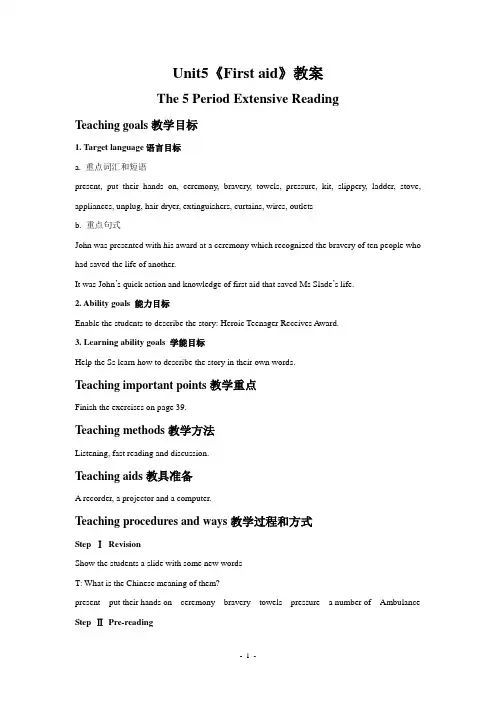
Unit5《First aid》教案The 5 Period Extensive ReadingTeaching goals教学目标1. Target language语言目标a. 重点词汇和短语present, put their hands on, ceremony, bravery, towels, pressure, kit, slippery, ladder, stove, appliances, unplug, hair dryer, extinguishers, curtains, wires, outletsb. 重点句式John was presented with his award at a ceremony which recognized the bravery of ten people who had saved the life of another.It was John’s quick action and knowledge of first aid that saved Ms Slade’s life.2. Ability goals 能力目标Enable the students to describe the story: Heroic Teenager Receives Award.3. Learning ability goals 学能目标Help the Ss learn how to describe the story in their own words.Teaching important points教学重点Finish the exercises on page 39.Teaching methods教学方法Listening, fast reading and discussion.Teaching aids教具准备A recorder, a projector and a computer.Teaching procedures and ways教学过程和方式Step ⅠRevisionShow the students a slide with some new wordsT: What is the Chinese meaning of them?present put their hands on ceremony bravery towels pressure a number of Ambulance Step ⅡPre-readingThe passage is in the form of a newspaper article and is an example of how knowledge of first aid can save lives. Let the Ss discuss the following scenario (=situation) in groups.T: Now boys and girls, imagine you can hear someone screaming. You find him sitting on the ground, bleeding heavily from deep knife wounds in his hands. What would you do? Will you help him? Will you call the police and ambulance, or whether you perform first aid?After a few minutes, the discussion is over.T: Today we are going to learn a story Heroic Teen-ager Receives Award. Skim the newspaper article and put the events in the correct order in Ex. 1.Five minutes later, check the answers.T: Good. From the answer, we know the main idea of the news. Often we readers only want to get a quick idea of a newspaper article and do not want to know all the details. For this reason they might read just the headline and the first paragraph. This is because the headline gives readers a clue about the content and the first paragraph gives the most important information. So we should pay attention to the first paragraph. It may give us a lot of information that answers the five “W” Questions: Who? What? When? Where? Why? And also How?Let the Ss read the headline of the newspaper article on p 38.T: What do you think the story is about by reading this headline?S: From the headline, we can guess that the story is about a young man who sets us a good example because he could save one’s life using his knowledge of first aid.Ask students to read the first paragraph and write the following question words on the Bb.T: Now, read the headline and the first paragraph to see if you can find the answer to the 5 W Questions. Who? What? When? Where? Why?Ss: Yes, I can find:Who? — John Janson;What? — was honoured at the Lifesaver Awards;When? — last night;Where? — in Rivertown;Why? — for carrying out lifesaving first aid on his neighbour after a shocking knife attack.T: Right. So we should pay more attention to the head-line and the first paragraph.Step ⅢWhile readingAsk the Ss to read the news from beginning to end. And then listen to the tape and answer the questions.1. What did John do when he heard the screaming?He was studying in his room.2. What happened to Anne?She had been stabbed repeatedly with a knife. She was lying in her front garden bleeding very heavily. Her hands had almost been cut off.3. What saved Ms Slade’s life?It was John’s quick action and knowledge of the first aid that saved her life.4. What first aid did John perform on Anne?John dressed Ms Slade’s in juries with tea towels and applied pressure to the wounds to slow the bleeding.5. What adjectives would you use to describe John’s actions? Give at least three.Brave, heroic, courageous, quick-thinking, quick-minded, helpful, fearless, unselfish, confident Step ⅣDiscussionDivide the class into groups to discuss the issues in Ex. 4. Make the discussions more lively by encouraging the Ss to think of different scenarios such as:1. Do you think John was silly or brave to get involved in the situation? Give reasons.2. Would you have done the same as John? Give reasons.3. Do you think it is worthwhile to take a course in first aid? Give reasons.4. What if the attacker had still been at the scene of the stabbing?5. What if the attacker had gone but had then returned to the woman?6. What if the woman had AIDS?7. What if John had performed first aid on the woman but she died anyway? How would he feel about having tried to help her?Show the above on the screen.T: Now let’s discuss the above questions.The students discuss for 5 minutes in groups and then share their ideas. Encourage the students to express their ideas. Have each group appoint a spokesperson to present their views to the class. Different answers are welcome.Sa: John was silly: he could have been attacked also, it was none of his business, the woman might have had AIDS.Sb: He was brave: he could have been attacked too, but he didn’t think about his own safty. All he thought about was how to help the victim.Sc: The Chinese saying Saveing one life is better than building up a 7-floor tower. I think anyone who is in that situation should help her....T: From the discussion, we can draw a conclusion that learning first aid knowledge is very important. You can use it to help others, even save one’s life. So try to do first aid before the doctor comes.Step ⅤTaskShow the following passages on the screen. Let the Ss read them and then talk about how to do first aid for drowning.Most children enjoy playing in water in hot summer. It’s messy and noisy and fun. Water can also be dangerous. It’s hard to remember that something so enjoyable can also be deadly. Take the time to protect your children from the dangers of water — a playful friend that can steal their lives in mere minutes. More than 1,000 American youngsters drown each year.Neighborhood swimming poolsAbout 300 children under the age of 5 drown each year in U.S. swimming pools. At the time of the incidents, most victims were being supervised by one or both parents. Nearly 70 percent of the children were not expected to be near the pool when they were found in the water.It takes only a few minutes for a child to drown. More than three-quarters of children who drown at neighborhood pools are missing from sight for less than five minutes. Drowning is also a silent death. There is no splashing to alert anyone that the child is in trouble.The key to preventing these tragedies is to have multiple levels of protection. The following precautions can help keep children safer around swimming pools:Fence it in. Pools should be completely surrounded by fencing material at least 4 feet tall. Chain link works well. A slatted fence should have no gaps wider than 4 inches, so kids can’t squeeze through. Gates should be self-closing and self-latching. The latch should be out of aInstall alarms. If your house is one of the walls of your pool enclosure, doors leading to the pool area should be protected with alarms. In addition, add an underwater pool alarm that sounds when something hits the water. Make sure you can hear the alarm inside the house.Cover it up. A motor-powered safety cover can provide a barrier over the water when the pool is not in use. The cover should withstand the weight of two adults and a child in case a rescue is needed.Choose an above-ground pool. Above-ground pools are much safer than in-ground pools, because the height of the pool serves as a barrier. However, you should remove the steps or lock them behind a fence when the pool is not being used.Teach children to swim. But remember that swimming lessons won’t drown-proof your child. The age to teach children to swim is the same as to ride a bike, age 5. Children under the age of 4 usually aren’t developmentally ready for formal instructions in swimming.Remove toys. Don’t leave pool toys bobbing in the water when no one is using the pool. Children may try to retrieve a toy and fall in.Keep your eyes peeled. Never leave a child un-supervised near a pool. During social gatherings near pools, adults can take turns being the “designated watcher.”Natural bodies of waterSwimming conditions are unpredictable in lakes, rivers and oceans. The depth can change rapidly, as can water temperature, currents and the weather. Murky water may conceal hazards. Follow these tips to be safer:Don’t swim alone. Teach children never to swim alone or without adult supervision.Wear a life jacket. Children should be required to wear a personal flotation device whenever riding in a boat or fishing, even along a river bank. Air-filled swimming aids, such as water wings, are no substitute for a life jacket.Jump before you dive. The first rapid descent into any body of water should be a jump —feet first. Diving into unknown water can result in a smashed skull or a broken neck.Avoid alcohol. Accidents increase with the amount of alcohol consumed. Teenage boys are at highest risk.Beware of thin ice. Drownings can occur in the winter, too. Avoid walking, skating or ridingon weak or thawing ice on any body of water.★Look at the two pictures on the screen. Imagine that you are at the scene. What should you do? What first aid will you perform on the drowning?A possible answer:Your first priority is to get a drowning child out of the water as soon as possible. If she isn’t breathing, place her on her back on a firm surface. Immediately begin rescue breathing, below, and have someone call for help. Don’t assume it’s too late to save a child’s life —even if she’s unresponsive, continue performing CPR and do not stop until medical professionals take over.1. To open your child’s airway gently tilt her head back with one hand, and lift her chin with the other. Put your ear to the child’s mouth and nose, and look, listen, and feel for signs that she is breathing.2. If your child doesn’t seem to be breathingInfants under age 1: Place your mouth over infant’s nose and lips and give two breaths, each lasting about 1/2 seconds. Look for the chest to rise and fall.Children 1 and older: Pinch child’s nose and seal your lips over her mouth. Give two slow, full breaths (1/2 to 2 seconds each). Wait for the chest to rise and fall before giving the second breath.3. If the chest rises, check for a pulse (see number 4). If the chest doesn’t rise, try again. Retilt the head, lift the child’s chin, and repeat the breaths.4. Check for a pulsePut two fingers on your child’s neck to the side of the Adam’s apple (for infants, feel inside the arm between the elbow and shoulder). Wait five seconds. If there is a pulse, give one breath every three seconds. Check for a pulse every minute, and continue rescue breathing until the child is breathing on her own or help arrives.5. If you can’t find a pulseInfants under age 1: Imagine a line between the child’s nipples, and place two fingers just below its center point. Apply five half-inch chest compressions in about three seconds. After fivecompressions, seal your lips over your child’s mouth and nose and give one breath.Children 1 and older: Use the heel of your hand (both hands for a teenager or adult) to apply five quick one-inch chest compressions to the middle of the breastbone (just above where the ribs come together) in about three seconds. After five compressions, pinch your child’s nose, seal your lips over his mouth, and give one full breath.All ages: Continue the cycle of five chest compressions followed by a breath for one minute, then check for a pulse. Repeat cycle until you find a pulse or help arrives and takes over.Step ⅥHomeworkWrite a short description of an accident and how to deal with the injuries in the accident.。
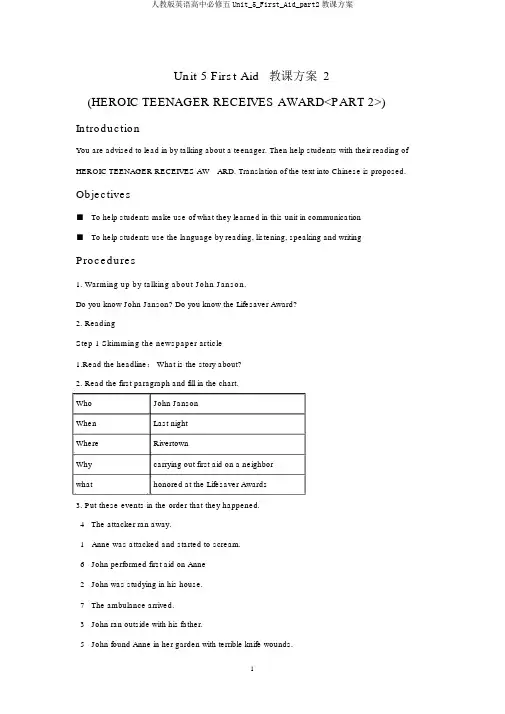
Unit 5 First Aid教课方案2(HEROIC TEENAGER RECEIVES AWARD<PART 2>) IntroductionYou are advised to lead in by talking about a teenager. Then help students with their reading of HEROIC TEENAGER RECEIVES AW ARD. Translation of the text into Chinese is proposed. Objectives■To help students make use of what they learned in this unit in communication■To help students use the language by reading, listening, speaking and writing Procedures1. Warming up by talking about John Janson.Do you know John Janson? Do you know the Lifesaver Award?2. ReadingStep 1 Skimming the newspaper article1.Read the headline: What is the story about?2. Read the first paragraph and fill in the chart.Who John JansonWhen Last nightWhere RivertownWhy carrying out first aid on a neighborwhat honored at the Lifesaver Awards3.Put these events in the order that they happened._4_ The attacker ran away._1_ Anne was attacked and started to scream._6_ John performed first aid on Anne_2_ John was studying in his house._7_ The ambulance arrived._3_ John ran outside with his father._5_ John found Anne in her garden with terrible knife wounds.4. Answer the questions1)What was John honored for?2)What did John do when he heard the screaming?3)What happened to Anne?4)What saved Ms. slade ’ s life?5)What first aid did John perform on Anne?6)What adjectives would you use to describe John’ s actions?Step 2 Discussion1.Do you think John was silly or brave to get involved in the situation? Give reasons.2.Would you have done the same as John? Give reasons3.Do you think it is worthwhile to take a course in first aid? Give reasons.Step Three Language study1.John was presented with hisT: Please open your books to Page 39.The first aid teacher is testi ng her students’ knowledge of first aid. What topics does the teacher ask questions about? Circle the correct ones from the box.T: Now let’ s cometothe second part of this exerci se. You can see four pictures there. Look atthese pictures, and match each picture with a topic listed in question 1 above.T:Next I ’ d like you to work in pairs, and use the pictures aboveot help you to give your partner firstaid instructions for each situation. Then I ’ ll ask you to perform your preparations to the class. Givethe students two to three minutes for them to prepare, and then ask several groups to the front to act out their diT:In the box of Exercise 1, there is an item called bruising, do you know what is?T: From the Internet we can find some articles about bruising.If the Internet is not available, the teacher can show the following passage to the students.Step 5 WritingT: Next I would like you discuss whether you think it is worthwhile to take a course in first aid.S:...T:Just now many of you think it is worthwhile to take a course in first aid. But there is no such course in our school. Do you want to persuade our headmaster to add this course to our curriculum?S:Yes.T:I ’ m very pleased to hear thatNow. I hope you to write a letter to give your suggestions to our headmaster about this.Example:Dear Headmaster:I am a student from Class 1, Grade 2.This week in our English class, we are learning a unit about first aid. In the course of learning this unit, we get to know that every year there are many people who get hurt or even killed because of some unexpected accidents. After discussion and searching the Internet, we think if we can learn some general knowledge at school, we can get some basicskills to save people’ s life as well as that of ourselves in theSofuturewethink. that it is important and necessary to have this kind course in our schoIt ’ s a pity that we have no such course in our schoolBut. we think that course on first aid not only can bring us knowledge but also can encourage our willingness to help others, and this is theGiven these reasons we think that the course of first aid is good to our students as well as to the whole society.Students of Class 1, Grade 2 Step 6 Homework1. Search the Internet for some information about the safety in gymnastic training and then write。
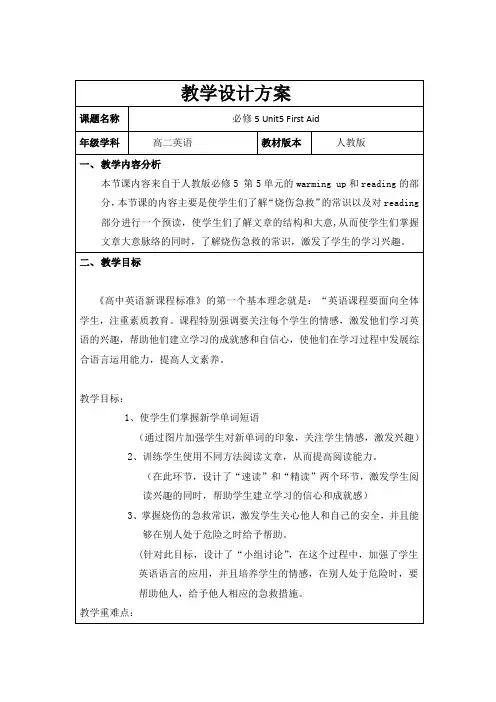
精美句子1、善思则能“从无字句处读书”。
读沙漠,读出了它坦荡豪放的胸怀;读太阳,读出了它普照万物的无私;读春雨,读出了它润物无声的柔情。
读大海,读出了它气势磅礴的豪情。
读石灰,读出了它粉身碎骨不变色的清白。
2、幸福幸福是“临行密密缝,意恐迟迟归”的牵挂;幸福是“春种一粒粟,秋收千颗子”的收获. 幸福是“采菊东篱下,悠然见南山”的闲适;幸福是“奇闻共欣赏,疑义相与析”的愉悦。
幸福是“随风潜入夜,润物细无声”的奉献;幸福是“夜来风雨声,花落知多少”的恬淡。
幸福是“零落成泥碾作尘,只有香如故”的圣洁。
幸福是“壮志饥餐胡虏肉,笑谈渴饮匈奴血”的豪壮。
幸福是“先天下之忧而忧,后天下之乐而乐”的胸怀。
幸福是“人生自古谁无死,留取丹心照汗青”的气节。
3、大自然的语言丰富多彩:从秋叶的飘零中,我们读出了季节的变换;从归雁的行列中,我读出了集体的力量;从冰雪的消融中,我们读出了春天的脚步;从穿石的滴水中,我们读出了坚持的可贵;从蜂蜜的浓香中,我们读出了勤劳的甜美。
4、成功与失败种子,如果害怕埋没,那它永远不能发芽。
鲜花,如果害怕凋谢,那它永远不能开放。
矿石,如果害怕焚烧(熔炉),那它永远不能成钢(炼成金子)。
蜡烛,如果害怕熄灭(燃烧),那它永远不能发光。
航船,如果害怕风浪,那它永远不能到达彼岸。
5、墙角的花,当你孤芳自赏时,天地便小了。
井底的蛙,当你自我欢唱时,视野便窄了。
笼中的鸟,当你安于供养时,自由便没了。
山中的石!当你背靠群峰时,意志就坚了。
水中的萍!当你随波逐流后,根基就没了。
空中的鸟!当你展翅蓝天中,宇宙就大了。
空中的雁!当你离开队伍时,危险就大了。
地下的煤!你燃烧自己后,贡献就大了6、朋友是什么?朋友是快乐日子里的一把吉它,尽情地为你弹奏生活的愉悦;朋友是忧伤日子里的一股春风,轻轻地为你拂去心中的愁云。
朋友是成功道路上的一位良师,热情的将你引向阳光的地带;朋友是失败苦闷中的一盏明灯,默默地为你驱赶心灵的阴霾。
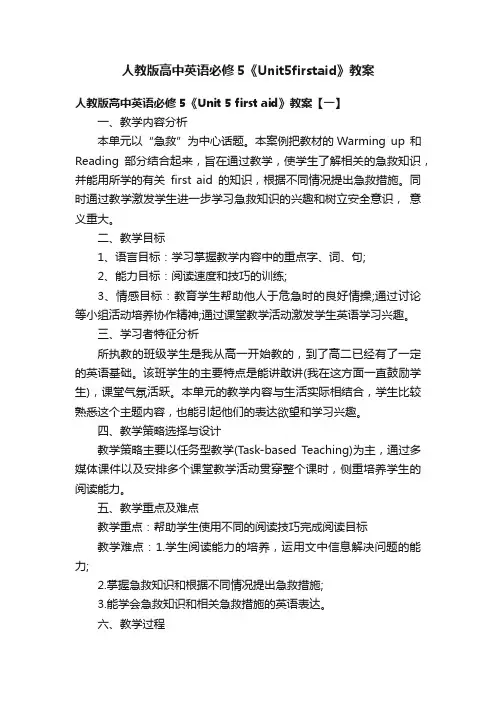
人教版高中英语必修5《Unit5firstaid》教案人教版高中英语必修5《Unit 5 first aid》教案【一】一、教学内容分析本单元以“急救”为中心话题。
本案例把教材的Warming up 和Reading部分结合起来,旨在通过教学,使学生了解相关的急救知识,并能用所学的有关first aid的知识,根据不同情况提出急救措施。
同时通过教学激发学生进一步学习急救知识的兴趣和树立安全意识,意义重大。
二、教学目标1、语言目标:学习掌握教学内容中的重点字、词、句;2、能力目标:阅读速度和技巧的训练;3、情感目标:教育学生帮助他人于危急时的良好情操;通过讨论等小组活动培养协作精神;通过课堂教学活动激发学生英语学习兴趣。
三、学习者特征分析所执教的班级学生是我从高一开始教的,到了高二已经有了一定的英语基础。
该班学生的主要特点是能讲敢讲(我在这方面一直鼓励学生),课堂气氛活跃。
本单元的教学内容与生活实际相结合,学生比较熟悉这个主题内容,也能引起他们的表达欲望和学习兴趣。
四、教学策略选择与设计教学策略主要以任务型教学(Task-based Teaching)为主,通过多媒体课件以及安排多个课堂教学活动贯穿整个课时,侧重培养学生的阅读能力。
五、教学重点及难点教学重点:帮助学生使用不同的阅读技巧完成阅读目标教学难点:1.学生阅读能力的培养,运用文中信息解决问题的能力;2.掌握急救知识和根据不同情况提出急救措施;3.能学会急救知识和相关急救措施的英语表达。
六、教学过程教师活动学生活动设计意图Step 1. Leading-in1. Greetings2. What words can you think of when talking about home accidents and first aid?3. First aid quiz (according to the pictures shown on Page 33)4. Definition of first aid: a temporary form of help given to someone who suddenly falls ill or gets injured before a doctor can be found.GreetingsBrainstorming(cut, nosebleed, choking, burn...)Watch, read and think, then work in groups to make the choicesRead aloud and understand the definition通过问题自然引入本课内容日常急救知识小测试,使学生自然顺利进入新课学习让学生朗读理解定义Step 2. Pre-readingPresent the picture on Page 33 and ask the students to answer the questions of Pre-reading.Ask the students to look at the title and subtitle, and predict: What may be written in the text? Look at the picture carefully and discuss in groups. Choose one student to give the answers. (Answers can vary)Students look at the title and subtitle and give their prediction. 利用课文图片导入主题:FIRST AID FOR BURNS 培养学生通过标题和小标题预测阅读内容的能力,也激发学生进一步阅读以验证预测Step 3. While-readingReading for general idea1. Make the students to skim the passage in limited time and get a general idea, then ask the students to divide the passage into 5 parts.2. In which order are these topics covered in the text?(Page 35)Reading for details (Get the students to read the text part by part)1. Ask the question:What is skin? What can get the skin burned? What is the function of the skin?2. Types of burns and their characteristics. Do Ex.2 of Page 35.(Label the pictures)3. Answer the following questions. (Ex.3, Page 35)Students skim the passage to find the answer.Students work individually to give the right answers.Students read and find out the answers. Do related exercises.限时阅读培养学生快速阅读的能力和通过略读理解大意独立完成,培养学生独立学生的能力,同时也是为了充分了解学生的课文理解情况培养学生把握文章细节的能力; 培养学生通过阅读寻找所需信息的能力; 培养学生根据信息进行判断的能力Step 4. Post-reading1. Give a few minutes for the students to read after the tape.2. Ask the students to judge the treatments of Ex.4.3. Ask the students to practise to give first aid treatments to different burns and then act it out.Students read aloud after the tape.Students read and make their judgement.Students practise in groups and act. 语音语调锻炼,同时也使得学生进一步理解所学课文本环节为输出阶段,目的在于检查学生的学以致用创设活动任务,培养学生解决实际问题的能力Step 5. Homework1. Get more about first aid from the newspaper, magazine or the Internet.2. Find out the important and difficult words and expressions to you and finish exercises on page 36.Students get ready for homework. 所布置的作业把学生的学习任务从课堂延伸到课外,有利于巩固课堂所学和进一步让学生掌握更多的急救知识七、教学评价设计评价采用了自我评价、小组比赛、学生互评和教师评价相结合的方式。
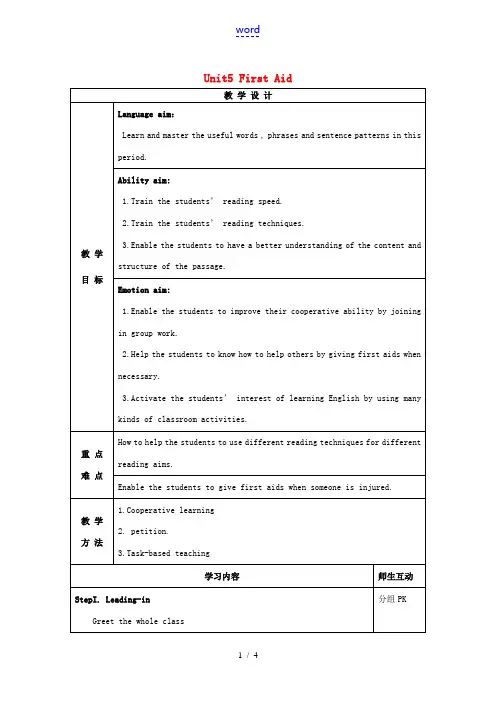
Unit5 First AidStepⅡ. Present 6 pictures and ask1.What has happened?2.How to deal with it?StepⅢ.Talk about the picture and answer the questions.1.What has happened to the little girl?2.What can we do to help her?StepⅣ. Fast readingRead the text quickly and finish the task: In which order are these topics organized in the text? Number them from 1 to 5.____ the three types of burns____ what to do if someone gets burned____ the purpose of skin____ the symptoms of burns____ how we get burnsStepⅤ. Detailed readingRead Part 1 and write down the purpose of skin:1〕Protect you against , and;2〕Keep you or ;3) Prevent you from ;4) Give you .Read Part 2 and find out the causes of burns.You can get burnt by : ________________________________________ 认真观察,各小组积极发言StepⅣ快速限时默读4’,理解文章分段及大意StepⅤ1.听录音,填写。
2.仔细阅读,从课文中找出关键词,培养学生查找kettle, steam pour out ofRead Part 3 and find out some information about types of burns.There are _______ types of burns depending on which _______ are burned._______________ affect only the _____ layer and should feel better within _______________.________________ affect both the _____ and the_______ layer. These burns are _______ and take ______________ to heal.________________ affect all ______ layers and any ______ and ______ under the skin. They are very _______ injuries and the victim must go to a ________at once.Read part 4 carefully, match the types of burns with the pictures and answer some questions.Types of burns CharacteristicsExtremely painfulRead part 5 carefully. Do you know why:1.Why should you put cold water on a burn?_______________________________________________________2.Why doesn’t a third degree burn hurt?_______________________________________________________StepⅤ.DiscussionStepⅥ.Summary 细节的能力。
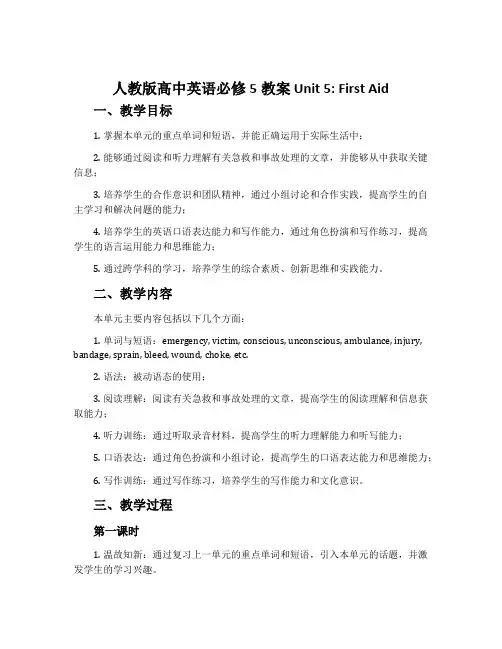
人教版高中英语必修5教案 Unit 5: First Aid一、教学目标1.掌握本单元的重点单词和短语,并能正确运用于实际生活中;2.能够通过阅读和听力理解有关急救和事故处理的文章,并能够从中获取关键信息;3.培养学生的合作意识和团队精神,通过小组讨论和合作实践,提高学生的自主学习和解决问题的能力;4.培养学生的英语口语表达能力和写作能力,通过角色扮演和写作练习,提高学生的语言运用能力和思维能力;5.通过跨学科的学习,培养学生的综合素质、创新思维和实践能力。
二、教学内容本单元主要内容包括以下几个方面:1.单词与短语:emergency, victim, conscious, unconscious, ambulance, injury, bandage, sprain, bleed, wound, choke, etc.2.语法:被动语态的使用;3.阅读理解:阅读有关急救和事故处理的文章,提高学生的阅读理解和信息获取能力;4.听力训练:通过听取录音材料,提高学生的听力理解能力和听写能力;5.口语表达:通过角色扮演和小组讨论,提高学生的口语表达能力和思维能力;6.写作训练:通过写作练习,培养学生的写作能力和文化意识。
三、教学过程第一课时1.温故知新:通过复习上一单元的重点单词和短语,引入本单元的话题,并激发学生的学习兴趣。
2.导入新课:介绍本单元的学习目标并让学生做预测,激发学生的学习兴趣和学习动力。
3.新课讲解:通过教师讲解和多媒体展示,讲解本单元的重点单词和短语,并进行例句的讲解和练习。
4.学习活动:分组进行单词和短语的拼写和运用训练,培养学生的团队合作和解决问题的能力。
5.拓展延伸:通过课堂讨论和小组展示,让学生拓展和延伸本单元的话题,培养学生的思维能力和创新能力。
第二课时1.温故知新:通过复习上一课的重点单词和短语,引导学生回忆上节课的内容,并复习被动语态的用法。
2.导入新课:通过展示一段有关急救的视频,激发学生的学习兴趣和对急救知识的关注。
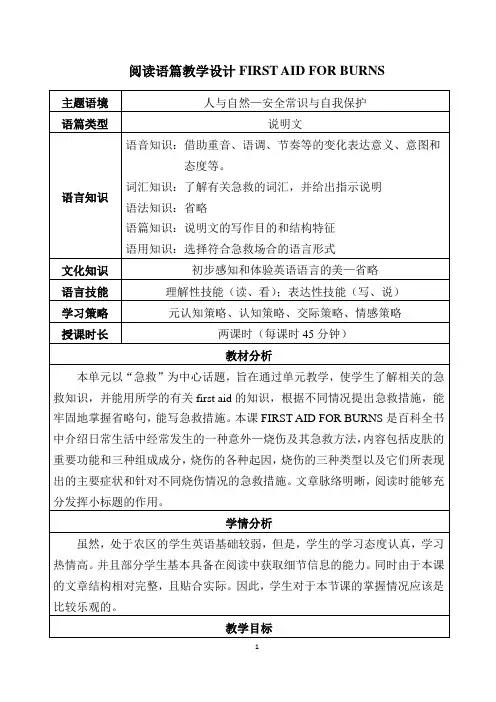
阅读语篇教学设计FIRST AID FOR BURNSTeaching procedures (40min)I. Lead-in(5min)Ask students to look at the picture of Pre-reading and give the answers to Exercises1&2 and what they should do. Give students some burns numbers to showthe importance of learning some knowledge of burns.设计意图:利用图片创设情境,导入主题,激活学生对烧伤的认知。
Show students learning objectives: 1. to know more about the words and expressions of FIRST AID FOR BURNS; 2. to improve the abilities of reading; 3. to learn how to treat different types of burns.设计意图:展现本节课学习目标,指导学生抓住本节课重点。
Play a game to finish the first learning objective. Divide the whole class into 6 groups. Which group gives the right meaning of the words, and which group will get 1 point.设计意图:通过小组PK形式进行词汇检测,在阅读前,扫清阅读障碍。
II. Reading (24min)Step2 : Scanning(10min)Ask students to read paragraph1&2, functions of skin and causes of burns, in 5 minutes and finish Task2.Task2: Read para.1&2 and then answer the question➢Functions of skin:What are the functions of skin?A. Protect you against disease, poisons, and the sun’s harmful raysB. Keep you warm or cool and prevent your body from losing too much waterC. Give you your sense of touchD. All of A, B and CSuggested answer: D➢Causes of burns:________;________;________;________;________;________;________Suggested answers: hot liquids, steam, fire, radiation, the sun, electricity, chemical Ask students to read paragraph3&4, types of burns and characteristics of burns, in 5 minutes and label these pictures first, second and third degree and then match its characteristics.Task3: Read para.3&4 and then finish the task3➢ Types of burns:Suggested answers: second degree burns, first degree burns, third degree burns ➢ Characteristics of burns:Suggested answer: 213设计意图:训练学生根据问题的关键词,快速获取课文信息的能力。
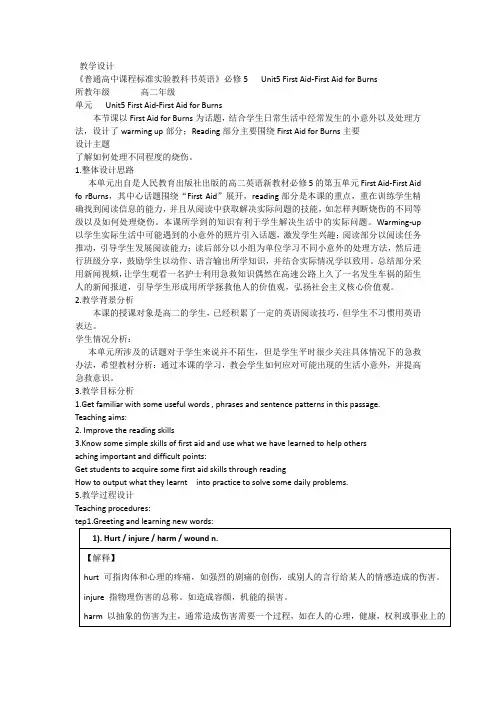
教学设计《普通高中课程标准实验教科书英语》必修5 Unit5 First Aid-First Aid for Burns所教年级高二年级单元Unit5 First Aid-First Aid for Burns本节课以First Aid for Burns为话题,结合学生日常生活中经常发生的小意外以及处理方法,设计了warming up部分;Reading部分主要围绕First Aid for Burns主要设计主题了解如何处理不同程度的烧伤。
1.整体设计思路本单元出自是人民教育出版社出版的高二英语新教材必修5的第五单元First Aid-First Aid fo rBurns,其中心话题围绕“First Aid”展开,reading部分是本课的重点,重在训练学生精确找到阅读信息的能力,并且从阅读中获取解决实际问题的技能,如怎样判断烧伤的不同等级以及如何处理烧伤。
本课所学到的知识有利于学生解决生活中的实际问题。
Warming-up 以学生实际生活中可能遇到的小意外的照片引入话题,激发学生兴趣;阅读部分以阅读任务推动,引导学生发展阅读能力;读后部分以小组为单位学习不同小意外的处理方法,然后进行班级分享,鼓励学生以动作、语言输出所学知识,并结合实际情况学以致用。
总结部分采用新闻视频,让学生观看一名护士利用急救知识偶然在高速公路上久了一名发生车祸的陌生人的新闻报道,引导学生形成用所学拯救他人的价值观,弘扬社会主义核心价值观。
2.教学背景分析本课的授课对象是高二的学生,已经积累了一定的英语阅读技巧,但学生不习惯用英语表达。
学生情况分析:本单元所涉及的话题对于学生来说并不陌生,但是学生平时很少关注具体情况下的急救办法,希望教材分析:通过本课的学习,教会学生如何应对可能出现的生活小意外,并提高急救意识。
3.教学目标分析1.Get familiar with some useful words , phrases and sentence patterns in this passage. Teaching aims:2. Improve the reading skills3.Know some simple skills of first aid and use what we have learned to help othersaching important and difficult points:Get students to acquire some first aid skills through readingHow to output what they learnt into practice to solve some daily problems.5.教学过程设计Teaching procedures:tep2.Lead-in(Teacher should take some photos about daily accidents of students before lass.) Look at the pictures. What happened to the students? What should we do to helphem? (Draw students' attention to the topic "First Aid")2. Task1:What is first aid?A form of help given to someone who suddenly fall ill.There are other times when giving first aid quickly can save people's lives.Step3. Reading1.Fast reading:Task2:Scan for the structure of the passagePart 1:The Introduction of the skinpart 2: the characteristics of burnsPart 3: the treatment of burns2.Detailed reading:1.:What may cause burns?2: What is the feature of second degree burns?3: Why is it necessary to remove the burns?Step 4: Summarize and homework。
英语:Unit5《First aid》教案(3)(新人教版必修5)Period One warming up and readingTeaching Goals:1.Encourage the students to discuss accidents and first aid .2.Enable the students to talk about different accidents and how to give first aid in different situations.3.Enable the Ss to learn how to use what they’ve learnt to do first aid treatment for burns correctly.4.Let the Ss learn the reading skill of getting the main idea of each para./ part & each passage . Key Teaching PointsHow to improve the Ss’ reading abili ty.Difficult points1. How to grasp the main idea of each paragraph / part & each passage.the students to use the expressions to describe the accidents and how to give first aid. Teaching methods1. Brainstorm & Skimming & scanning methods to make the Ss get a good understanding of thetext.2.Discussion methods to make the Ss understand what they’ve learned in class.3.Pair work of group to get every student to take part in the teaching-and-learning activities. Teaching proceduresTeaching aidsA recorder, a projector, and a computerStep One Warming upT: Let’s check our homework each otherStep Two PresentationT: Let’s check our homework each otherStep Two Presentation1.Lead-in question: Watch a video, and fill in the blanks: what is first aid?First aid is a temporary form of help given to someone who suddenly falls ill or gets injuredbefore a doctor can be found. Often the illness or injury is not serious, but there are other times when giving first aid quickly will save one’s life.2. Warming-up: Brainstorming: What words can you think of when you talk about accidents and first aid?Quiz for first aid (on p74)1. The best way to treat a hurt ankle is to:A.Put an ice pack on your ankle.B.Put a heating pad(垫子)around your ankle.C.Keep on walking and jumping.2. If you get a nosebleed, gently let your head back to stop the bleeding.A. TrueB. False3. To treat a burn, you:A. Rub(擦)some butter on it.B. Hold the burnt part under cold running water.C. Put salt on the burnt part.4. You should wait at least five minutes before touching somebody who has been struck by lightening, or you might get a shock (打击). A. True B. Falsefriend has an asthma(哮喘) attack, but she doesn’t have her medicine. You’d better:A. Get a paper bag for her to breathe into.B. Get her a cup of coffee.C. Take her outside for fresh air.6. To treat a choke, you should make him /her spit by patting him/her on the back.A. TrueB. False7. If someone is having a heart attack, you should first:A. Call 120B. Perform CPR (心肺复苏)person would you help first?___A Li Yan who has cut her foot on glassB Xue Jin whose nose is bleedingC GaoY uan who is on the ground not breathingD Wang Feng who has broken her arm. carrying out rescue breathing, how many times a minute should you blow air into the victim’s mouth? ______. A 4 B 8 C 15 D 2010. How would you stop severe bleeding? ___A cover the wound with plasticB wash the woundC do nothing as the bleeding will stop by itselfD put a bandage over the wound and then press on it5 A friend is choking on a piece of food and is coughing badly. What should you do?___A nothingB carry out rescue breathingC have her lie down and restD slap her four or five times on her back4. A snake bite; a nose bleeding; a sprained ankle; choke; drown; burn; a broken Step Three Group discussioa. What happen in each picture and what kind of first aid should you give in the following situatioTalk about different situations and the way they should give first aid.Qs: Turn to page 33, look at the happened in each picture? What kind of first aid should you give?A snake bite: A snake has bitten him on his leg.(The person bitten must get to a doctor or hospital at once; /Speed is very important. /It will help the doctor greatly if you can tell him what kind of snake it was, or describe the situation .)Bleeding: She has cut her arm with some broken glass and is bleeding badly.(Try to stop the bleeding;/Press a handkerchief onto the bleeding point and hold it there;/Hold up the part of body which is bleeding if possible.)*(watch the video about how to deal with bleeding )A sprained ankle: He has badly sprained his ankle.(Tied with medical bandage. /It is better to avoid walking with the injured ankle. /It is correct to use ice bag for removing pain and bleeding, and also not influence our own body healing.)*( a video about a sprained ankle)Choking : She is choking on a piece of food (Make him /her spit by patting him/her on the back./ Don’t eat too fast and don’t forget to chew your food./To avoid this, we shouldn’t talk or laugh when eating.)*(a video about unconscious choking)A broken arm : She has broken her arm. (Do not move the patient. /Send for an ambulance at once. /Treat for shock if necessary.A bleeding nose: He has a nose/a nose bleed.(Stay calm. / Breathe through the mouth, not the nose. / Sit up and bend the head slightly forward. / Pinch捏both nostrils鼻孔shut using a thumb and forefinger./ Spit out any blood that collects in the mouth.Step Two Pre-reading:1. Questions for the picture on P33:What has happened? What sort of injuries the child will have?What kind of first aid would you perform in the situation of burning?Key: Cool the area of skin; Wash it under the cold running water.Cover the wound with bandage/clean cloth. See a doctor if necessary.Step Three Fast readingLet the Ss read the passage fast and then find out the answers to the questions1. What will the passage be about?2. What do they tell you about the passage?3. In which order are these topics covered in the text? Number them from 1 to 5.In which order are these topics covered in the text? Number them from 1 to 5.(P35Ex1) (3) the three types of burns(5) what to do if someone gets burned(1 ) the functions of the skin(4) the symptoms of burns(2) how we get burnsStep Four Detailed reading Fill in the blankscan skin do for our body ?.Protect you against diseases, poisons and the sun’s harmful rays..Keep you warm or cool..Prevent you from losing water..Give you sense of touch.of burnsYou can get burnt by : hot liquids; steam; fire radiation; the sun electricity and chemicals of burnWhat are they?degree burns.2. Second degree burnsdegree burns4. Label these pictures first, second and third degree burns.(P35 Ex2)5.Fill in the blanks Types & characteristics of burns (based on page 34)6..Answer the questions(Page35 Ex3)1).Why should you put cold water on a burn?Because the cold water stops the burning process, stops the pain and reduces the swelling.2). Why doesn’t a third degree burn hurt?Because in the third degree burn the nerves have been damaged. If there are no nerves, there is no pain.3). Why do you think clothes and jewellery near burns should be removed?Because bacteria from the clothes and jewellery could infect the burns.4). If someone has a third degree burn, why might you see tissue?Because all the layers of the skin have been burnt showing the tissue underneath.7.Decide whether the first aid treatment is Right (R) or Wrong (W). (35 Ex4)。
Unit 5 First Aid 教案 <人教版新课标必修五)Period 4 Grammar Ellipsis教学设计目标Grasp the grammar :Ellipsis (the types ,the ways>教学设计要点:Master the rules of ellipsis教学设计难点:How to make the students master the uses and the rules of the grammar.b5E2RGbCAP 互动研究导学研究导学在英语中,为了防止重复而省去某些重复的部分,这种现象叫省略。
如:1> 2>Beg you pardon. --- < I ) Beg you pardon.Sounds like a good idea.--- ( It > Sounds like a good idea..p1EanqFDPw一简单句中的省略1、省略主语( It > doesn 祈使句中主语往常省略’ t matter.( It > Sounds like a good idea.2、省略主谓或主谓语的一部分。
如:<省略主语和谓语)1> What/How (do you think> about a cup of tea ?2> Why (do you> not say hello to him ?省略表语。
1> –Are you thirsty? –Yes, I am .(thirsty>.2>His brother isn’ t lazy, nor is his sister .(lazy>.DXDiTa9E3d4、同时省略几个成分1>Let ’ s meetatthe same place as--- (we met> yesterday.同时省略主、谓语RTCrpUDGiT2>–Have you finished your work ?–Not yet.-----I have not finished my homework yet.二并列句中的省略1、两个并列句中,后一个分句常省略与前一分句中同样的部分。
2016年秋季学期高二英语集体备课教案Module 5 Unit 5First aid2016-12-19Book5 Unit5 First Aid Ⅰ. 单元教学目标Teaching goals:1.能力目标Goals2.知识目标法First degree burns turn white when (they are ) pressed.重点句子1)Burns are called first degree burns,second degree burns or third degree burns.2)These burns affect both the top layer of the skin and they affect the second layer of the skin.3)John was presented with his award at a ceremony whichrecognised the bravery of ten people who had saved the life of another.4) They discovered that Anne Slade, mother of three, had been stabled repeatedly with a knife.5) It was J ohn’s quick action and knowledge of first aid that saved Ms Slade’s life.3.情感目标本单元的中心话题是“急救”。
通过本单元教学,让学生了解有关急救的常识,意识到了解一些基本的急救措施对生活的重要性,着重培养学生学以致用的能力。
在理解的基础上,用较为流利的英语表达在生活中如何处理一些突发事件,然后实施紧急救护等。
Ⅱ.Teaching Arrangement: Nine periodsPeriod ContentsPeriod 1 Warming up and speakingPeriod 2 Pre-reading & ReadingPeriod 3 Reading and Language pointsPeriod 4 Exercises and GrammarPeriod 5 Using languagePeriod 6 Reading and Language pointsⅢ. Teaching Procedures:The First PeriodWarming upKnowledge AimsThe definition of first aid.The names of some injuries and sudden illnesses.Ability AimsTo collect information of the ways dealing with sudden illnesses and unexpectedinjuries.Get the exact idea of the instructions of first aid in the listening material.Emotion AimsLearn to give first aid to those who need it according to what they learn during this period. Teaching important and difficult points教学重难点Help the students to use the expressions to describe the accidents and how to give first aid. Teaching procedures and ways 教学过程与方式Step1 Lead-in:Step 1 GreetingsT: In last unit we learned about making news.See if you are a journalist, on your way to cover an event, you find a person who has got a snakebite, what will you do to him/her?Ss: Send him/her to the nearby hospital.T: That’s a good idea.But if the hospital is quite far away, what can you do at first to save the person’s life?T: Have you ever had such kind of experience?T: Sometimes we can come across such kind of unexpected injury, and it is necessary for us to learn some general knowledge about how to deal with this kind of situation.That’s what we are going to learn in this unit.Now open your books to Page 33.Let’s have a look at the first lesson.Step 2 Describing PicturesT: Here on Page 33, there are 6 pictures, please have a look at them and see what has happened to each person on the picture.Give Ss three to five minutes to talk about the pictures or discuss the pictures with their partners.T: Now, who’d l ike to describe the first picture?S1: The man has been bitten by snake and he feels terrible now.S2: We can see the glass of the window is broken and the lady’s arm is bleeding.Maybe it is cut by the broken glass.S3: A group of boys are playing football on the playground, but one of them has got a sprained ankle.The boy feels painful.S4: The girl is having her breakfast, but she has got choked.S5: She might slipped from the stairs and she has got her arm broken.S6: The boy is playing under a tree, and he might have knocked into the tree and got a bloody nose.T: You all have done a very good job.Now, have you ever met such kind of situations?S: Yes.T: Did you or someone else give help in any of them?If so, what kind of help?Let students say whatever they think of.T: In English we call this kind of help First Aid.What is first aid?Why is it important?(Ask students to read the defination and importance of first aid in the Warming up and fill in the blanks.)Fill in the blanks:First aid is the first kind of help given to someone who suddenly falls ill or gets injured before adoctor can be found.Often the illness or injury is not serious, but there are other times when giving first aid quickly will save one’s life.Step3 Quiz for first aid (on p74) (Nowadays there are a lot of unexpected accidents. what would you do in such situations?)Step4 Speaking in pairs What happened in the picture? What kind of first aid should you give?)Try to choose one of the pictures you can talk to do the role play:What’s wrong with you?/Where have you got hurt? How are you feeling now?I got….Can I help you?You should…./you shouldn’t…Give the students some more situations and encourage the students to talk more.Step4 DiscussionWhat would you do in the following situations?What could we do to prevent these accidentsDrowning :Check to see if he /she is breathingTry to start his /her breathingLearn how to swim./Swim with a life-buoy/Never swim alone./Never swim in deep water. etc.Traffic accident: Call for a doctor or an ambulance.Never pull her out of the carFind enough people to lift the car safely and take her to hospital at once.Use crosswalks and look at both sides when crossing the street./Follow the traffic rules and be careful/Never use a cellphone while driving, riding a bike or walking on a busy street. etc.Step5 Language Points1.aid n./vt. 帮助,援助,赞助first aid (to the injured) 急救medical aid 医疗救护[短语联想]给与/进行急救帮助某人做come/ go to sb’s aid 援助某人aid sb in doing sthwith the aid of 在… 的帮助下aid sb. to do sth.为了帮助… aid sb with sthEg. (汉译英)①He came to my aid at once.②He was able to find the museum with the aid of a map.③He raised money in aid of the sick.③We aided him in raising the money.④He aided me with money.④I aided her to continue her study.另: a hearing aid, teaching aidsA dictionary is a very useful aid in learning language.2. fall ill 病到fall [fell fallen]用作连系动词,后常接形容词.fall + adj.(asleep/silent/sick/awake etc.)对比:fall ill 生病属短暂性动词, 不与for + 时间段连用be ill 指生病的状态,是持续性行为, 可与for + 时间段连用His wife suddenly fell ill last week.He has been ill for a week.3. get injured 受伤get+过去分词( burnt/dressed/lost/paid/drowned/caught in Etc.) 表被动或状态eg. The computer got damaged when we were moving.My bike is getting repaired now.My glasses got broken while I was playing basketball.Peter and Mary got married last year.Sarah, hurry up. I am afraid you can’t have time to ___before the party. (2004)A. get changedB. get changeC. get changingD. get to change*4. injure vt, 指意外或事故造成损/受伤, 强调功能的损失injury [C]the injured (adj.) 伤员He was badly injured in the accident.Last night a terrible storm hit the area and many people were injured.5. save one’s life(lives) 救某人的命save one’s honor 保全名誉save one’s face 保全面子save one’s skin 避免受伤6. Did you or someone else give help in any of them? If so, …If so, = If it is true,Do you want to be a superman? If so, come with me!7. bite v. (bit, bitten)bite….to deathbite off more than one can chew贪多嚼不烂Once bitten, twice shy. 吃一堑,长一智。